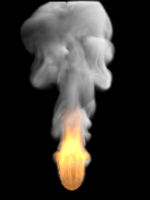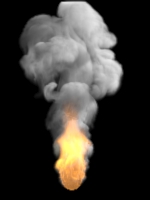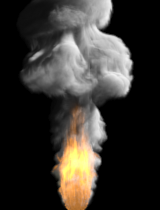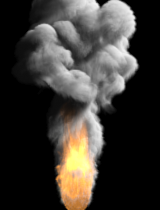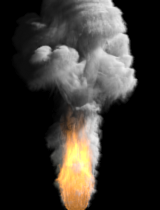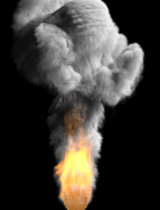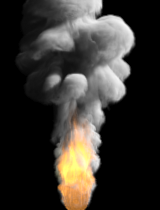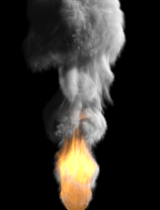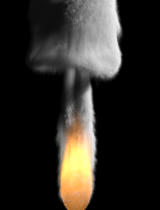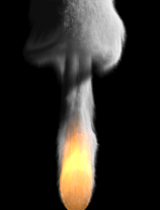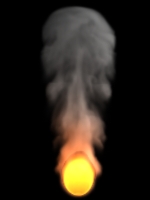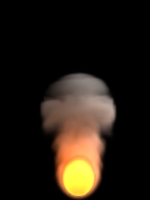System

Gravity - This value defines gravity strength. The resulting force of gravity on a fluid causes buoyancy. That means that the fluid that has a different density that the surrounding will rise or fall. Hot air from fire has lower density than the surrounding air which causes it to rise. The influence of gravity is that it multiplies Smoke, Fuel and Temperature buoyancy values. Note that in zero gravity, there is no buoyancy!
Vorticity - This parameter is very useful for coarse grids when simulation lacks detail.
With increased grid detail the need for vorticity is lower as the simulation itself produces more detail. Higher vorticity will increase the number and strength of small vortices in the fluid.
FumeFX offers two different Vorticity types.
Vorticity I
Strength ??? This parameter is used to control the amount of small scale vortices that are added to the simulation. High values might cause smoke to dissipate and decelerate.
|
|
|
|
|
Strength: 0.0 |
Strength: 0.2 |
Strength: 1.0 |
Vorticity II
Vortices Scale: This parameter controls the scale of generated vortices. Higher values will tend to create a stream like motion while small values will tend to spread the motion outwards.
Note: It is recommended that the Vortices Scale parameter stays below value of 0.5 and that the ratio of Strength and Vortices Scale does not exceed 50. If this parameter???s value is above 0.5 or ratio becomes higher than 50, a warning asterisk symbol will appear in front of the Vortices Scale spinner.
|
Stren: 0.2 Scale: 0.001 |
Stren: 0.5 Scale: 0.001 |
Stren: 1.0 Scale: 0.001 |
|
Stren: 0.2 Scale: 0.01 |
Stren:0.5 Scale: 0.01 |
Stren: 1.0 Scale: 0.01 |
|
Stren: 0.2 Scale: 0.1 |
Stren: 0.5 Scale: 0.1 |
Stren: 1.0 Scale: 0.1 |
|
Stren: 0.2 Scale: 0.5 |
Stren: 0.5 Scale: 0.5 |
Stren: 1.0 Scale: 0.5 |
|
Stren: 0.2 Scale: 1.0 |
Stren: 0.5 Scale: 1.0 |
Stren: 1.0 Scale: 1.0 |
Velocity Damping - This gradually slows down the speed of flow, simulating internal friction.
|
|
|
|
|
Damping: 0.0 |
Damping: 0.01 |
Damping: 0.1 |
X/Y/Z Turbulence - Add artificial disturbance to smoke and fire on each axis separately or on all together. The Turbulence Noise Group offers further modification.

